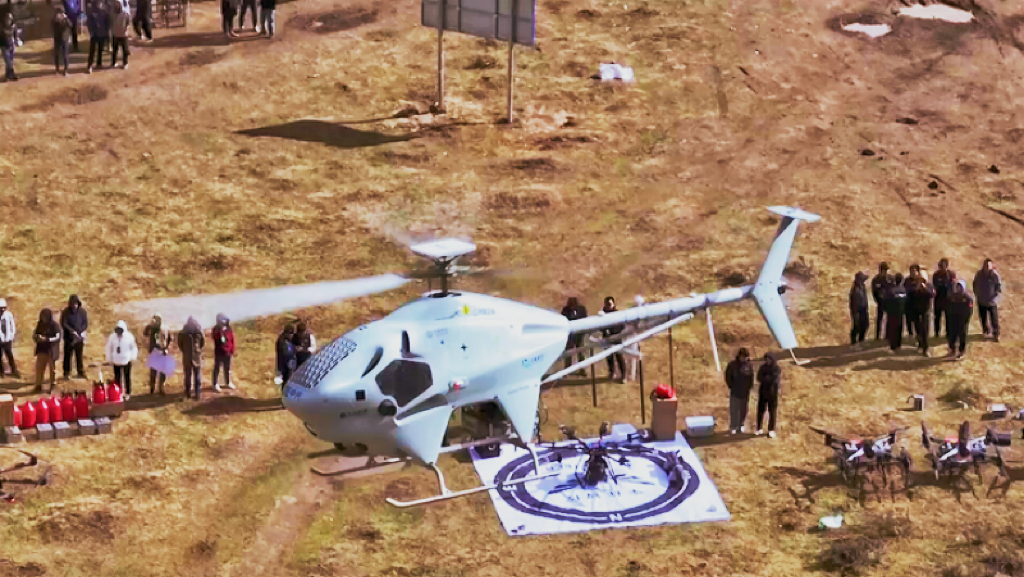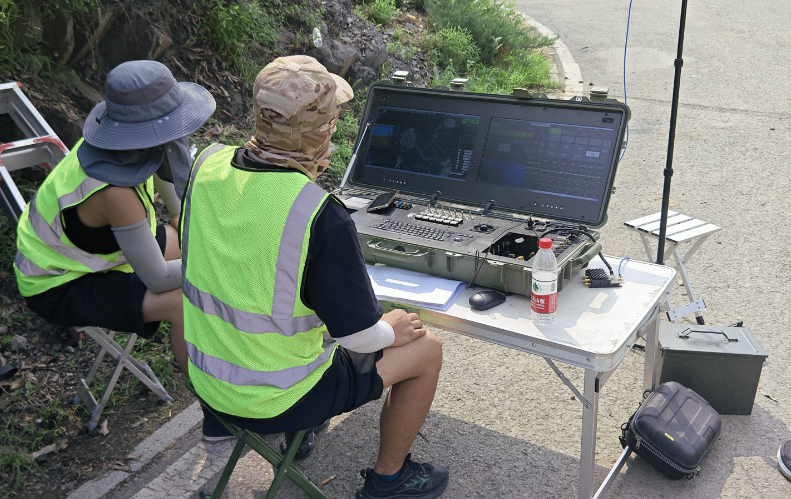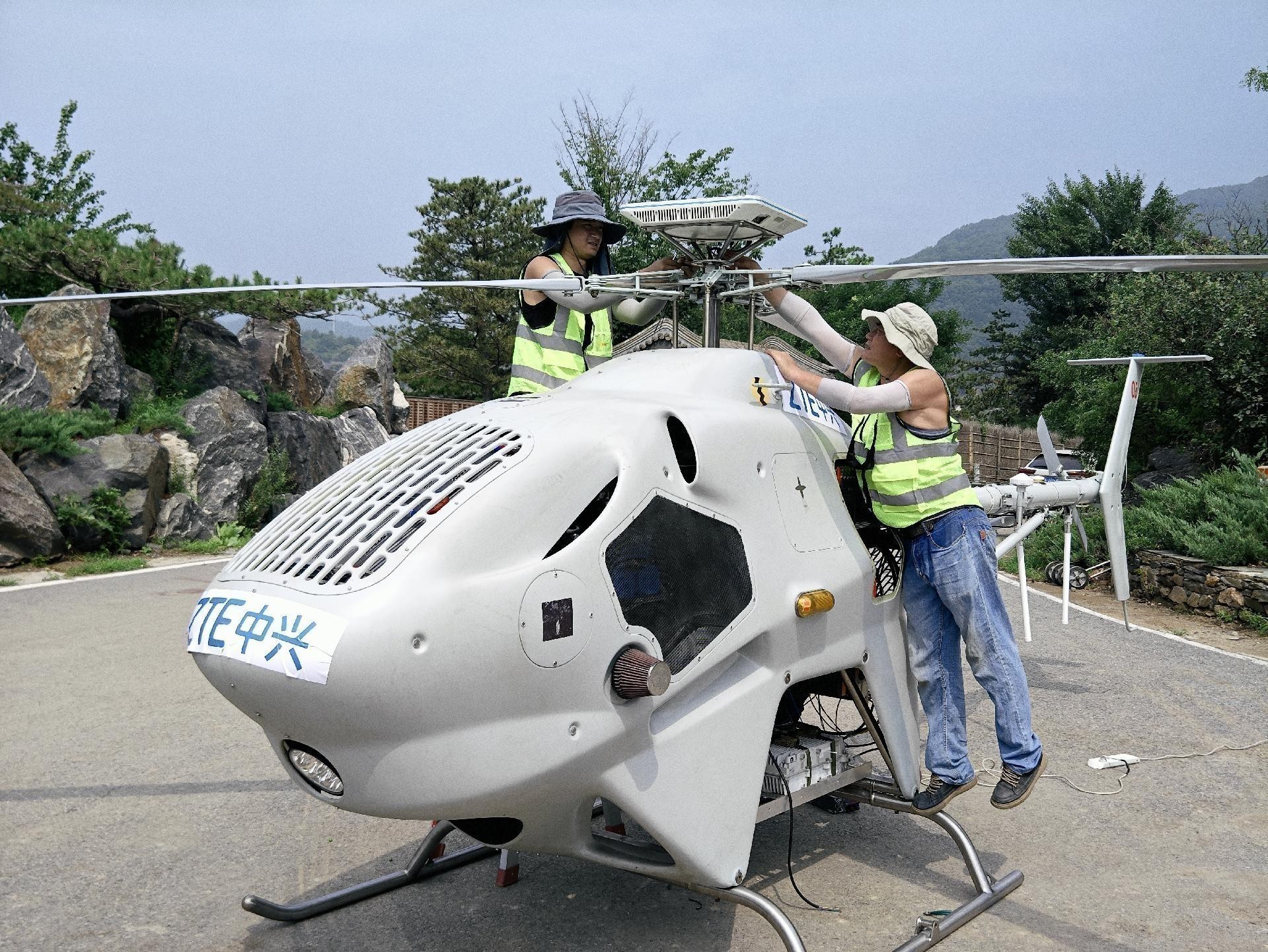Emergency Connectivity: Enabling Last-Mile Access
The impacts of global climate change are leading to a rise in extreme weather events and disasters. In the face of destructive natural disasters, critical infrastructure like communication, transportation, and power often suffer damage. Therefore, wireless emergency communication systems have become indispensable tools for disaster relief and rescue efforts. Faced with these complex emergency scenarios, establishing a comprehensive emergency communication support system has become more important than ever.
Drawing upon its expertise in connectivity and computing power, ZTE has developed a digital infrastructure for intelligent emergency response, utilizing end-to-end products across various scenarios and pervasive digital intelligence, thereby continuously enhancing the infrastructure for emergency connectivity.
Unmanned Helicopter Validation of 'Three Disconnection' Rescue Scenarios
ZTE showcased its "Heavy Payload Long-endurance Unmanned Helicopter Emergency Communication System" during the 'Three Disconnection' Scenario Rescue Validation in 2023 at the Shangri-La Lake test site in Sichuan Province, which stands at an altitude of 3,626 meters. ZTE's performance was outstanding, successfully completing both the planned validation and the presentation tasks.
The validation targeted the critical "last mile" challenges in emergency rescue operations under extreme conditions. It encompassed four key areas in the 'Three Disconnection' scenarios at high altitudes: beyond-visual-range disaster reconnaissance, long-range communication support, long-range material delivery, and on-site firefighting with visual-range bombing. This comprehensive test rigorously evaluated the helicopter's flight performance, operational efficiency, and mission capabilities in real-world scenarios.
ZTE's "Heavy Payload Long-endurance Unmanned Helicopter Emergency Communication System" stands out among all participating companies as the only systematic emergency rescue system equipped with public network base stations, PDT cluster private networks, Mesh self-organizing networks, and satellite relays. This integrated system offers comprehensive communication support for the public and emergency response teams at the 'Three Disconnection' sites, complete emergency command support, and all-round disaster situation awareness. During the field test, the unmanned helicopter took off from the forward base at Shangri-La Lake, ascended 1,000 meters, and swiftly reached the distant 'Three Disconnection' test point 6 kilometers away. The evaluation team experts established a video link with the forward base. At the experts' request, the site also simultaneously connected to at least seven WeChat video calls, all of which had smooth conversations and clear, uninterrupted video feeds. According to backend data provided by the public network operator, the maximum number of RRC connections during the test was 81, with 39 users online concurrently.
During the presentation, after successfully ensuring voice calls, SMS, web browsing, video viewing, and video calls at the 'Three Disconnection' site, ZTE team extended the distance by an additional 5 kilometers. Even at this increased range, only minor video buffering occurred. This further confirmed the stability of the flight platform, the efficiency of the mission operations, and the high performance and excellent coverage of the communication support system.
The "Heavy Payload Long-endurance Unmanned Helicopter Emergency Communication System" showcased by ZTE boasts multiple access methods, versatile task capabilities, broad environmental adaptability, large capacity, extensive coverage, and long flight duration. Impressively, all testing tasks can be accomplished with the unmanned helicopter. Evaluators from the expert group commented that ZTE's demonstration was not just about an emergency communication system but represented a comprehensive emergency rescue communication support system. It is well-suited to meet the demands of real-world emergency scenarios.
ZTE's Unmanned Helicopter Wireless Station Providing Emergency Connectivity in Flood Relief
In July 2023, Tianjin, Hebei, Beijing and other regions in China endured an unrelenting 72-hour deluge, courtesy of Super Typhoon Doksur. The unprecedented rainfall shattered records and wreaked havoc, triggering flooding, hampering daily life, disrupting public safety, and causing substantial property damage. Among the affected areas, Mentougou district, with its unique terrain, bore the brunt of the disaster. In such times of crisis, the region's lifeline - its telecommunications network - became paramount for restoring essential infrastructure.
Flood relief efforts swung into action as telecom operators and vendors deployed emergency response teams, each with a specific role to play. Among them, the Unmanned Helicopter Wireless Station demonstrated its prowess in delivering vital emergency communication support.
The Ministry of Industry and Information Technology (MIIT) took charge, dispatching a ZTE Unmanned Helicopter Wireless Station to the affected areas immediately. This mobile site, equipped with signals from all local telecom operators including China Telecom, China Mobile, and China Unicom, swiftly restored communication services in Wangping Town and Tanzhe Temple Town.
Jiang Xiangyang, Chief Marketing Engineer at ZTE, provided insights into the innovative approach. "Mentougou's complex mountainous terrain and severe flooding had damaged communication infrastructure," he explained. ZTE, alongside local operators and partners, worked tirelessly to recover mobile services by deploying ZTE Unmanned Helicopter Wireless Station. They extended aerial mobile networks to disaster-stricken communities for days, ensuring the reestablishment of vital communication channels.
From the planning stage to real-life deployment, ZTE's efforts in emergency communication solutions have been extensive. This journey encompasses the development of tethered UAS mobile sites, nomadic mobile sites, backpack mobile sites, and, most notably, the multi-operator Unmanned Helicopter Wireless Station. In partnership with key industry players, this initiative has harnessed cutting-edge technology to deliver critical communication services in challenging environments.
The Unmanned Helicopter Wireless Station offers a wide range of features, including the ZTE Unisite Intelligent full-band and multi-operator mobile base station system. It utilizes a petrol-driven helicopter with long-range capabilities and a high-throughput Ka-band satellite terminal. This innovative solution has undergone extensive testing, and flight data highlights the helicopter's impressive capabilities, covering an area of nearly 80 square kilometers, with an impressive six-hour aerial endurance. It provides voice, SMS, and internet services for approximately 2,400 users simultaneously during the Mentougou Relief operations.
The success of this initiative was further demonstrated by its swift takeoff, ability to function in extreme weather conditions, and flexibility in adapting to diverse terrains. Additionally, it can support public voice broadcasts and enhance emergency communication applications, a testament to ZTE's creative integration of mobile and satellite communication technologies with high-performance unmanned helicopter technology.
As the Unmanned Helicopter Wireless Station was prepared for its next mission, it became clear that this innovative solution has a bright future in shaping the landscape of emergency communications for natural disasters worldwide.
In the face of unprecedented natural disasters, the innovative technology of ZTE's Unmanned Helicopter Wireless Station emerges as a beacon of hope. Swift deployment, remarkable capabilities, and adaptability in adverse conditions have marked this solution as a game-changer in disaster relief. With a commitment to continuous improvement and a vision of enhancing mobility and versatility, ZTE, alongside its dedicated partners, is poised to play an even more significant role in emergency communications worldwide.
Mission Accomplished
ZTE has been steadfast in actively participating in earthquake relief, flood rescue, typhoon response, and other disaster relief efforts in recent years. Leveraging our leading R&D capabilities, we continually break through key technologies. This commitment ensures that our advanced products and solutions are refined and validated in real-world emergency scenarios, consistently contributing the 'ZTE strength' to emergency relief endeavors.


